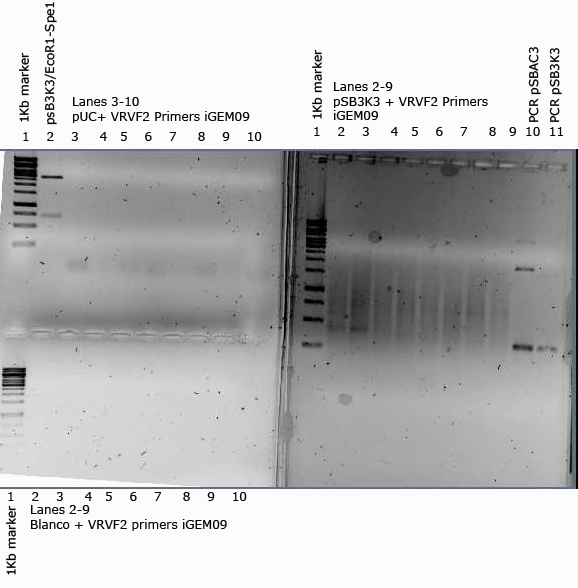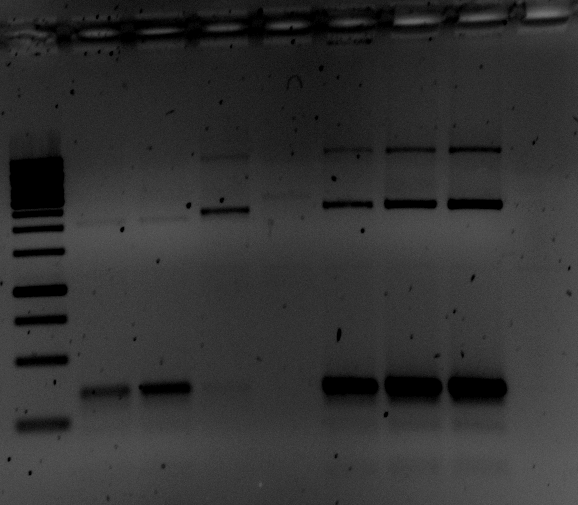Team:Groningen/Notebook/22 July 2009
From 2009.igem.org
Wet
GVP Cluster
3A assembly of pSB1AC3, GVP, J23109, 106 and 100 (continued)
Transformation
- 2 uL Ligation mix added to TOP10 competent cells from -80 stock
- 30 min incubation on ice
- 5 min heatshock 37°C
- 5 min on ice
- 950 uL LB added to eppendorfcup
- 50 uL cells are added to the LB
- Incubation: 1 hour, 37°C, waterbath shaker
- 100 uL cells are streaked on LB agar plates (150 ug/ml Chloramphenicol)
- Centrifugation: 1 min, 19000g
- Pellet resuspended in 100 uL LB and streaked on LB agar plates (150 ug/ml Chloramphenicol)
Transporters
Metal Accumulation
Vectors
In order to check the VR VF2 primers that were ordered this year a gradient PCR was done with a vector that is expected to work , a pUC vector and a negative control with no vector.
|
|
As a check-up we also did a restriction analysis for the vector with EcoR1 and Spe1
| 10x fast digest buffer | 2 uL |
| pSB3K3 (22,5 ngr/uL) | 8 uL (=180ngr up to 1ugr is recommended at fermentas) |
| EcoR1 | 1 uL |
| Spe1 | 1 uL |
| MilliQ | 8 uL |
| Total | 20 uL |
- Mix gently and spin down
- incubate at 37° for 30 min.
Results of the PCR and restiction shown below. Bands were expected in the pSB3K3 lanes with VR-VF2 primers at 316bps. A band somewhat larger than 316 can be seen in lanes 2,3 (50°, 51.5°).
The expected band for the digestion is 2727 bps, which is about the size of the band shown in the figure above. But there is no PCR product seen on gel, this might mean that the primers are not correct and at least that there seems to be no contamination of DNA in the primers. The PCR will be repeated.
- Check VR/VF2 PCR products (21 July 2009) of pSB3K3 + promoters and pSB1AC3 + promoters on gel
From left to right: 1kb marker (Fermentas), pSB3K3-promoter1 (low), K3-promoter2 (high), K3-promoter3 (med), pSB3K3 (control), pSB1AC3-promoter1 (low),AC3-promoter2 (high), AC3-promoter3 (med).
All show PCR product of ~300-350bp (except K3-3 which is very faint), but as the control shows no band it is not possible to say if the promoter insert can actually be found in the plasmid.
- Number of colonies of inducible promoters transformants
| transformants | # colonies |
| pSB1A2 + R0010 (pLac) | 30 + 50-70 on the concentrated plate |
| pSB2K3 + I0500 (pBAD) | none |
As the pSB2K3 + I0500 (pBAD)was not succesfully transformed, the transformation was redone.
- Get more plasmid and single colonies for glycerol stocks
Grew o/n cultures of:
- pSB1A2-R0010 (pLac) from 2 colonies in LB-Amp
- pSB1AC3 with 3 promoters and pSB1AC3 empty in LB-Cam
- pSB3K3 with 3 promoters and pSB3K3 empty in LB-Kan
Made single colony plates of:
- pSB1A2-R0010 (pLac) from 2 colonies in LBA-Amp
- pSB1AC3 with 3 promoters in LBA-Cam
- pSB3K3 with 3 promoters in LBA-Kan
Grew o/n @ 37dg.
Dry
Jasper had a look at ArsD and Annelies at ArsAB, but at some point we realized that ArsA and ArsD might actually only be on some plasmids and may not be part of the genome of our E. coli (DH10B). To verify this we searched for a database which we could use for BLASTing (which we found) and BLASTed the sequences of several ars genes. The results (which can be viewed at Team:Groningen/BLAST) indicate that our E. coli most likely indeed does NOT have ArsA and/or ArsD, it most likely only has ArsB, ArsC and ArsR. This should save us quite a bit of work!
Today we worked on the efflux of arsenic by ArsA ArsB and ArsD. KB looked at ArsB first we looked at diffrent papers and we found some very promising ones In the afternoon we looked especially at As(III) and Sb(III) Uptake by GlpF and Efflux by ArsB in Escherichia coli by Yu-Ling Meng, Zijuan Liu, and Barry P. Rosen‡ [link] Escherichia coli* what it's influence is on the efflux of As and Sb, the influence of NADH, the influence of FCCP and the influences As and Sb on each other.
|
|
|
| |||||||||||||||||||||||||||||||||||||||||||||||||||||||||||||||||||||||||||||||||||||||||||||||||||||||||||||||||||||||||||||||||||||||||||||||||||||||||||||||||||||||||||||||||||||||||||||||||
|
|
|
| |||||||||||||||||||||||||||||||||||||||||||||||||||||||||||||||||||||||||||||||||||||||||||||||||||||||||||||||||||||||||||||||||||||||||||||||||||||||||||||||||||||||||||||||||||||||||||||||||
 "
"


